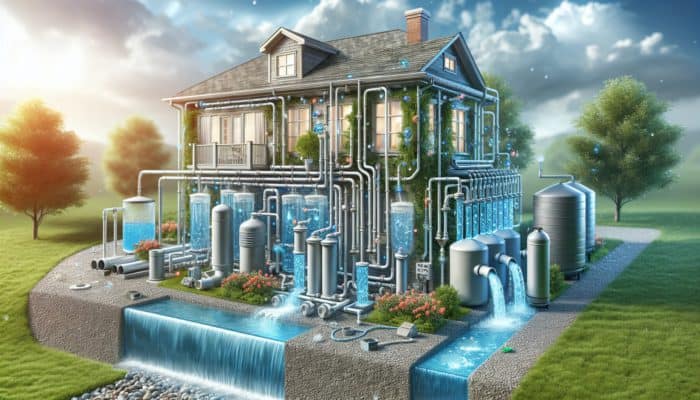Understanding the Essentials of Rainwater Harvesting
Defining Rainwater Harvesting and Its Importance

Rainwater Harvesting: Rainwater harvesting refers to the strategic collection and storage of rainwater for various uses, primarily sourced from rooftops and other suitable surfaces. This environmentally friendly practice not only conserves precious water resources but also diminishes dependence on conventional water supplies, a vital consideration in regions grappling with water scarcity. By effectively capturing rainwater, communities can bolster their water supply systems, thereby mitigating the adverse effects of droughts and variable water availability. The rainwater collection process initiates as rainfall occurs, directing the water into a dedicated collection system. Subsequently, this stored water can be repurposed for numerous applications, including irrigation, drinking, and industrial uses. The global trend towards adopting rainwater harvesting is on the rise as awareness increases regarding its critical role in resource conservation and promoting sustainable living.
The method of Rainwater harvesting begins with rainfall, where the water is redirected into a system designed for collection. This water is then stored for various applications, including irrigation for gardens, drinking purposes where permitted, and industrial processes. The growing adoption of rainwater harvesting systems worldwide signifies a shift in societal values towards sustainability and resource management, demonstrating a collective effort to embrace environmentally responsible practices.
Exploring the Multifaceted Benefits of Rainwater Harvesting
The benefits of rainwater harvesting extend well beyond mere water conservation, encompassing a range of economic, environmental, and social advantages. Firstly, this practice can lead to a significant reduction in water bills, particularly in urban settings where water prices can be steep. By harnessing harvested rainwater for non-potable uses, such as landscape irrigation and toilet flushing, both households and businesses can significantly reduce their dependence on municipal water supplies, resulting in substantial financial savings.
Additionally, the environmental sustainability promoted by rainwater harvesting is noteworthy. It plays a critical role in recharging local groundwater supplies, managing stormwater runoff, and mitigating erosion and flooding risks in urban environments. These ecological benefits foster healthier ecosystems and enhance local biodiversity. Furthermore, during periods of drought, the presence of a self-sufficient water supply offers peace of mind and fortifies communities against the unpredictability of climate change.
Exploring Effective Methods for Rainwater Collection
There are numerous methods available for rainwater harvesting, each presenting distinct advantages tailored to various environments. The rooftop system stands out as one of the most prevalent techniques, where rainwater is collected from building rooftops via gutters and downspouts. This method proves particularly effective in urban areas, where the expansive roofs can capture considerable volumes of rainfall. Alternatively, ground catchments are employed, utilising larger surface areas to gather water from the ground, making them suitable for rural landscapes.
Furthermore, rainwater collection can also be effectively implemented from paved areas, allowing urban spaces to redirect stormwater into storage systems. Each method of collection comes with its own set of considerations, including cost, maintenance requirements, and adherence to local regulations. A thorough understanding of these methods enables the selection of an approach that aligns with the specific needs and circumstances of the given location, ensuring optimal functionality and efficiency.
Diverse Applications of Rainwater Harvesting

The applications of rainwater harvesting are varied and adaptable, serving multiple purposes across different environments. In residential settings, collected rainwater can be utilised for irrigation, flushing toilets, and laundering clothes, thereby promoting sustainable water use in everyday activities. In commercial environments, businesses can establish systems that not only reduce water costs but also enhance their sustainability initiatives, utilizing rainwater for maintaining landscapes or even for cooling systems in industrial operations.
Agricultural applications of rainwater harvesting are particularly crucial in global water management strategies. Farmers can leverage collected rainwater for crop irrigation, especially in drought-prone areas, improving crop resilience while reducing reliance on over-exploited groundwater sources. The versatility of rainwater harvesting highlights its significance as a sustainable solution to a myriad of water-related challenges faced by society.
Understanding the Operational Mechanisms of Rainwater Harvesting
Key Components of a Rainwater Harvesting System
A standard rainwater harvesting system comprises several essential components that work synergistically to ensure the efficient collection, storage, and utilisation of rainwater. The initial component is the gutter and downspout system, which channels rainwater from rooftops into a designated storage tank. The design and strategic placement of these components are paramount for maximising water collection while minimising the risk of contamination.
Subsequently, the storage tank serves as a reservoir for the collected rainwater, allowing users to access it as needed. Filtration systems are crucial for maintaining the cleanliness and safety of water, effectively removing debris, leaves, and other contaminants before the water enters the storage tank. Finally, the distribution network, comprising pipes and valves, facilitates the delivery of harvested rainwater to various applications, such as irrigation or household use. Each component must be meticulously chosen and maintained to optimise the overall functionality of the system.
Step-by-Step Guide to Installing a Rainwater Harvesting System

The installation of a rainwater harvesting system involves several critical steps that ensure its effectiveness and longevity. The first step is to conduct a comprehensive site assessment, evaluating factors such as roof area, rainfall patterns, and intended uses for the collected water. Based on this assessment, the appropriate components must be selected, including gutters, storage tanks, and filtration systems.
- Conduct a thorough site assessment to identify optimal collection methods.
- Select components suited to local conditions and specific needs.
- Install gutters and downspouts to channel rainwater efficiently into collection tanks.
- Establish a filtration system to ensure water purity before storage.
- Position storage tanks for convenient access and easy maintenance.
- Connect the distribution network to ensure effective use of harvested water.
- Conduct a system test post-installation to identify any leaks or issues.
Engaging professional installation services can significantly enhance system performance, ensuring that all components function seamlessly and cohesively. Following installation, user education on system maintenance is essential to ensure maximum efficiency and durability over time.
Ensuring Longevity: Maintenance of Rainwater Harvesting Systems
Regular maintenance is essential for preserving the longevity and efficiency of rainwater harvesting systems. This includes routine inspections and cleaning of gutters and downspouts to prevent blockages caused by debris, leaves, or sediment. A well-maintained collection system significantly enhances both the quality and quantity of harvested water.
In addition to regular cleaning, it is crucial to inspect the filtration system. Filters should be routinely replaced or cleaned to avert contamination of stored water. Storage tanks must also be monitored for any signs of damage or contamination, with water quality testing recommended to ensure safety for their intended applications. Establishing a maintenance schedule and diligently keeping records can help identify issues early, ensuring the system operates at optimal performance.
Insights from Experts on Rainwater Harvesting
Expert Guidelines for Ensuring Rainwater Quality
To guarantee the safety and usability of harvested rainwater, experts advise regular water quality testing. This practice is vital for detecting potential contaminants that could pose health risks. Depending on the intended application—be it irrigation or potable water—specific quality standards must be adhered to.
- Test water for contaminants such as bacteria, heavy metals, and nitrates.
- Implement effective filtration systems to eliminate impurities.
- Consider employing UV light or chemical disinfection for potable applications.
- Regularly monitor pH levels to ensure water is suitable for its intended use.
Moreover, maintaining the cleanliness of collection surfaces and storage tanks is of paramount importance. Experts suggest proactive measures, such as installing first-flush diverters, which can significantly enhance water quality by redirecting the initial runoff that is often more contaminated. Following these expert recommendations ensures that harvested rainwater remains a safe and valuable resource.
Innovations Shaping the Future of Rainwater Harvesting
The field of rainwater harvesting is undergoing rapid technological advancements, significantly improving system efficiency and usability. Innovations such as smart sensors for real-time monitoring are becoming increasingly prevalent. These sensors can gauge water levels, assess quality, and even notify users when maintenance is required, thereby enhancing both convenience and performance.
Additionally, advanced filtration technologies are emerging, employing materials such as activated carbon or membrane filters to elevate the quality of collected rainwater. Integrated storage solutions are being developed to optimise space utilisation, facilitating the incorporation of rainwater harvesting systems into urban environments. Collectively, these innovations streamline the harvesting process while enhancing user-friendliness and effectiveness.
Learning from Successful Case Studies in Rainwater Harvesting
Investigating successful implementations of rainwater harvesting systems can yield invaluable insights into best practices and potential challenges. For instance, a residential community in California has successfully implemented a rainwater harvesting system, which has reduced their water bills by up to 50%. By utilising rooftops and shared storage tanks, the community exemplifies how collaborative efforts can amplify benefits.
In another notable example, an agricultural project in Australia employed rainwater harvesting techniques to irrigate crops during dry seasons. By capturing and storing rainwater, farmers were able to sustain their yields while diminishing reliance on costly groundwater resources. These case studies underscore the practical advantages of rainwater harvesting, highlighting its potential for water conservation, cost savings, and resilience against climate variability.
The Environmental Significance of Rainwater Harvesting
Understanding the Environmental Benefits of Rainwater Harvesting
The environmental advantages of rainwater harvesting are extensive and multifaceted. By alleviating the demand on traditional water sources, rainwater harvesting helps conserve natural ecosystems that often face threats from over-extraction and pollution. Additionally, it reduces stormwater runoff, which can lead to soil erosion, flooding, and degradation of water quality in local waterways.
When rainwater is effectively captured and utilised, it can significantly relieve pressures on urban drainage systems, which frequently become overwhelmed during heavy precipitation events. This not only reduces the risk of flooding but also improves the quality of water that eventually enters rivers and lakes, thereby benefiting aquatic ecosystems. By promoting sustainable water management practices, rainwater harvesting makes a positive contribution to the overall health of the environment.
Reducing Carbon Emissions Through Rainwater Harvesting
Implementing rainwater harvesting systems can play a pivotal role in decreasing the carbon footprint associated with water usage. Traditional water supply methods, including treatment and distribution, require substantial energy inputs, leading to increased greenhouse gas emissions. By harnessing harvested rainwater, individuals and businesses can significantly reduce their reliance on energy-intensive municipal water services.
In regions where energy costs are directly linked to water treatment, particularly in urban centres, the incorporation of rainwater harvesting can yield notable energy savings. This not only lowers operating costs but also contributes to broader climate change mitigation efforts. As awareness of environmental issues increases, rainwater harvesting emerges as a crucial strategy for reducing carbon footprints and championing sustainable living practices.
Advancing Sustainable Development Through Rainwater Harvesting
Rainwater harvesting plays a crucial role in advancing global sustainable development goals. Advocating for water conservation and responsible resource management aligns with initiatives aimed at ensuring water availability and sustainable sanitation for all. This practice not only benefits individual households but also bolsters community resilience and sustainability.
Urban environments particularly benefit from rainwater harvesting, as it mitigates flooding risks and enhances water security. By capturing and utilising rainwater, cities can improve their infrastructure while lessening the burden on existing water supply systems. Furthermore, local governments and organisations are increasingly recognising the significance of rainwater harvesting within their development planning efforts, embedding sustainable practices into regional policies.
Enhancing Local Biodiversity Through Effective Rainwater Harvesting
By replenishing groundwater supplies and maintaining soil moisture levels, rainwater harvesting supports habitats that are conducive to local flora and fauna, thereby enhancing biodiversity in both urban and rural contexts. By providing a reliable water source, rainwater harvesting systems can nourish local ecosystems that may otherwise struggle during dry spells or drought conditions.
For instance, rainwater harvesting in community gardens can create microhabitats for various species, including birds and beneficial insects. In agricultural settings, the use of harvested rainwater can bolster crop health and resilience, fostering a more biodiverse farming environment. The implementation of rainwater harvesting not only aids in conserving water but also plays a significant role in preserving the ecological balance essential for thriving ecosystems.
Economic Benefits of Rainwater Harvesting
Realising Cost Savings Through Rainwater Harvesting
One of the most compelling economic benefits of rainwater harvesting is the potential for substantial cost savings on water bills. In many urban areas, where water expenses can be considerable, utilising harvested rainwater for non-potable uses such as irrigation and toilet flushing can significantly decrease expenditure. Households and businesses alike may notice a marked difference in their overall financial outlay over time.
While the initial investment in a rainwater harvesting system may seem daunting, this cost can often be offset by the long-term savings it provides. Many users find that their payback period can be as short as three to five years, depending on local water rates and system size. Additionally, as the awareness of water scarcity continues to grow, the adoption of rainwater harvesting may also enhance property value by bolstering sustainability credentials.
Evaluating the Return on Investment for Rainwater Harvesting Systems
Several factors, including local water rates, system size, and intended applications can influence the return on investment (ROI) for rainwater harvesting systems. In regions where water costs are particularly high, the ROI can be especially appealing, as the direct capture of rainwater translates into lower utility bills.
Moreover, the scale of the system plays an essential role in ROI calculations. Larger systems, which may incur higher initial costs, often offer greater returns over time, particularly in agricultural contexts where consistent irrigation is vital. Many users conclude that the savings generated by harvesting rainwater justify the initial investment, making it a financially prudent choice in the long run.
Exploring Funding and Incentive Options for Rainwater Harvesting
A variety of funding options and incentives are available to encourage the adoption of rainwater harvesting systems. Numerous governments and local authorities offer grants, rebates, and tax incentives designed to make the initial investment more accessible for households and businesses alike. These initiatives aim to foster sustainable water management practices and can substantially alleviate the financial barriers associated with implementing rainwater harvesting.
Additionally, certain non-governmental organisations (NGOs) and environmental groups provide financial support or low-interest loans to assist with the installation of rainwater harvesting systems. These funding opportunities broaden the accessibility of rainwater harvesting, encouraging more individuals and communities to invest in sustainable water solutions that yield benefits for both the environment and their economic circumstances.
Navigating Challenges in Rainwater Harvesting
Identifying Common Challenges in Rainwater Harvesting Implementation
While rainwater harvesting offers numerous advantages, several challenges may hinder its successful implementation. The initial costs associated with purchasing and installing a rainwater harvesting system can pose a significant barrier, particularly for low-income households. Furthermore, ongoing maintenance requirements can deter potential users who may lack the necessary knowledge or resources to manage the system effectively.
Another critical challenge is ensuring the quality of the harvested water. Without proper filtration and regular maintenance, collected rainwater can become contaminated, posing health risks. Users must also be aware of local regulations governing rainwater harvesting, as compliance can at times complicate the installation process. Addressing these challenges is essential for the successful adoption and sustainability of rainwater harvesting systems.
Implementing Solutions to Overcome Rainwater Harvesting Challenges
Innovative solutions are emerging to address the common obstacles associated with rainwater harvesting. Modular systems that are easy to install can significantly lower initial costs and simplify the installation process. These systems can often be scaled to meet user needs, making them more accessible to a broader range of households and communities.
Moreover, advancements in filtration technologies and educational initiatives focused on system maintenance can empower users to manage their systems effectively. Community workshops and comprehensive informational resources can provide essential training, ensuring that users are well-equipped to maintain their rainwater harvesting systems. By proactively addressing these challenges, more individuals can embrace the myriad benefits of rainwater harvesting.
Best Practices for Optimising Rainwater Harvesting Systems
To maximise the efficacy of rainwater harvesting systems, adherence to best practices is crucial. Regular maintenance, including gutter cleaning and tank inspections, is crucial for maintaining both water quality and system longevity. Proper sizing of system components is equally important; systems that are inadequately sized may fail to capture enough rainwater, while oversized systems could incur unnecessary expenses.
- Establish a consistent maintenance schedule to clean and inspect all components.
- Select the suitable size and type of tank based on local rainfall patterns and usage requirements.
- Ensure compliance with local regulations and guidelines governing rainwater harvesting.
- Install first-flush diverters to enhance water quality by discarding the initial runoff.
By following these best practices, users will not only enhance system performance but also contribute to the sustainability of local water resources. Cultivating a culture of responsible water management will ensure the enduring success of rainwater harvesting initiatives.
Frequently Asked Questions About Rainwater Harvesting
What is the primary objective of rainwater harvesting?
The primary aim of rainwater harvesting is to collect and store rainwater for subsequent reuse, thereby reducing reliance on traditional water sources while promoting sustainable water use practices.
In what ways can rainwater harvesting lead to financial savings?
Utilising harvested rainwater for non-potable applications can substantially lower water bills, particularly in areas with elevated municipal water rates.
What are the essential components of a rainwater harvesting system?
Key components include gutters, downspouts, storage tanks, filtration systems, and a distribution network to guarantee efficient collection and utilisation of harvested rainwater.
How frequently should rainwater harvesting systems undergo maintenance?
Maintenance should be performed regularly, with checks on gutters, filters, and tanks at least every other year to ensure optimal performance and water quality.
Is harvested rainwater safe for human consumption?
With appropriate filtration and treatment, harvested rainwater can be rendered safe for drinking; however, routine testing is advisable to ensure compliance with safety standards.
What are some of the most prevalent challenges associated with rainwater harvesting?
Common challenges encompass initial installation costs, ongoing maintenance demands, and ensuring water quality, which must be effectively managed for successful implementation.
Can rainwater harvesting systems be effectively utilised in urban environments?
Yes, rainwater harvesting is particularly effective in urban areas, as it leverages rooftops and paved surfaces to capture significant volumes of rainwater.
What are some innovative technologies currently being utilised in rainwater harvesting?
Innovations include smart sensors for real-time monitoring and advanced filtration systems designed to enhance the efficiency and usability of harvested rainwater.
How does rainwater harvesting contribute to environmental sustainability?
It alleviates pressure on conventional water resources, minimises stormwater runoff, and aids in preserving local ecosystems, thereby promoting environmental health.
What types of funding options are available for those interested in rainwater harvesting systems?
Many governments provide grants, rebates, and tax incentives to encourage the adoption of rainwater harvesting, making initial investments more affordable.
Join us on our journey on X!
Water Purifier Options: A Comprehensive Guide
Exploring the Innovations in Water Purifier Technology How Do Water Purifiers Function Effectively? Water Purifier Options: Water purifiers represent sophisticated systems meticulously engineered to eradicate contaminants from drinking water, thereby guaranteeing safe consumption for users. The fundamental technologies employed in water purification encompass a range of methods, including filtration, reverse osmosis, and UV sterilization. Each […]
Urban Noise Camouflage: A Universal Solution
Enhancing Urban Life Through Effective Noise Camouflage What Constitutes Urban Noise Camouflage? Urban Noise Camouflage: Urban noise camouflage is a crucial strategy that enhances the quality of urban living by utilizing a range of advanced techniques and innovative technologies to mitigate or reduce unwanted sounds. With the increasing urban density, the challenge of noise pollution […]
Urban Predator Awareness: Protecting Communities
Comprehending Urban Predators: An Essential Guide What Are Urban Predators and Why Are They Important? Urban Predator Awareness: Urban predators refer to species that have successfully adapted to live in metropolitan areas, creating potential challenges for both human safety and local wildlife. These fascinating creatures can often be spotted in parks, residential neighbourhoods, and even […]
Plant Identification Safety: Essential Tips for All
The Essential Role of Accurate Plant Identification Why Is Accurate Identification Critical for Safety and Enjoyment? Plant Identification Safety: Accurate plant identification holds immense significance for a multitude of reasons, particularly when embarking on outdoor adventures. Misidentifying plants can lead to severe consequences, such as toxic reactions, allergic responses, and unfortunate incidents during foraging or […]







Your exploration of rainwater harvesting truly resonates with me, particularly in the context of our increasingly unpredictable climate. In my own journey towards sustainability, I’ve realized how vital it is to rethink our relationship with water, a resource often taken for granted. The concept of strategically collecting rainwater not only speaks to practical conservation but also to a deeper cultural shift we must embrace—one that respects the natural cycles of our environment.
Ah, the joys of rainwater harvesting! I always find it amusing that we have such an abundant resource falling from the sky, yet it often goes to waste while we’re busy topping off our reservoirs with water that probably took a nice, long scenic trip through pipes. It’s like Mother Nature’s way of saying, “Hey, here’s some free water, just scoop it up and save yourself from paying that water bill!”